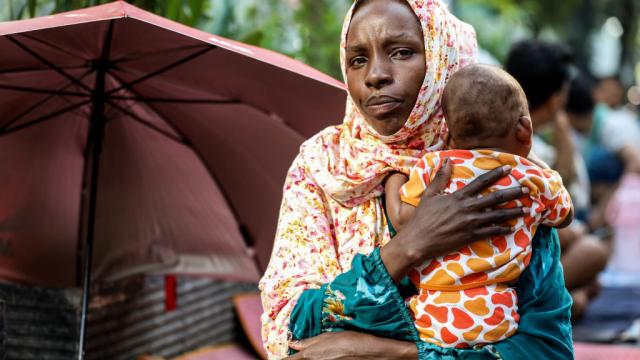June 20 is World Refugee Day. It’s dedicated to spreading awareness about the experiences of the 82.4 million people — a number that has doubled in the past 10 years — who have been displaced due to persecution, conflict, violence, human rights violations and disasters globally.
It’s also a time to acknowledge the incredible contributions refugees make to our communities, and how much value those contributions add to the fabric of Australian culture.
Despite this, however, there remain some pretty major misconceptions around the refugee experience. So I chatted with the team at The UN Refugee Agency Australia for UNHCR in an attempt to help gain some clarity.
Who makes up the majority of refugees?
You may be surprised to hear this, but more than two-thirds of all refugees or internationally displaced people come from just five countries. Recent data from UNCHR indicates that as of the end of 2020, 6.7 million refugees originated from Syria, followed by Venezuela at 4 million, Afghanistan at 2.6 million, South Sudan at 2.2 million and Myanmar at 1.1 million.
When you drill down further you’ll find that a considerable portion of those people are children.
Children account for almost half of all displaced people, currently. In data shared with Lifehacker Australia, the UNHCR shared that it “estimates that almost one million children were born into a refugee life between 2018 and 2020”. The reason for this is because of the sheer number of protracted refugee situations around the world, resulting in children being born into refugee status.
It’s also worth noting here that women and girls are often hardest hit when it comes to conflict situations and displacement. That includes “early or forced marriage, particular health and safety considerations [violence being a factor here], and marginalisation from education or employment opportunities”.
Where are most refugees hosted?
For the most part, refugees are hosted by developing countries (86%). UNHCR reports that across 2020, Turkey was the nation that “hosted the highest number of refugees and displaced people with just under 4 million”.
This was followed by Colombia, Germany, Pakistan and Uganda.
The number of refugees who are resettled each year is a fairly bleak figure, however. The UNHCR reports that “in 2020, refugee resettlement plunged to its lowest level almost two decades”.
Only 34,400 refugees were resettled into a new home last year. The figure is one-third of what was achieved in 2019. A devastating side effect of the pandemic and the myriad of restrictions on travel that emerged (including pauses on resettlement programmes, UNHCR shares).
How long do most people live under refugee status?
According to UNHCR, in 2020 there were close to 15.7 million refugees who had been living in exile for at least five years.
“Displacement can last 20 years on average for refugees and more than 10 years on average for those internally displaced by conflict, violence or disaster,” Australia for UNHCR National Director, Naomi Steer shared over email.
What’s the difference between people seeking asylum and refugees?
If you’ve ever found yourself unsure of these terms, Steer has offered this explanation.
“An asylum seeker is a person seeking international protection because they fear persecution or they have experienced violence or human rights violations. In countries with individualised procedures, an asylum seeker is someone whose claim has not yet been finally decided on by the country in which the claim is submitted. Not every asylum seeker will be recognised as a refugee, but every refugee starts out as an asylum seeker.
“A refugee is a person who asked for protection and was given refugee status. They may have been resettled in another country or be waiting for resettlement. They are defined and protected in international law, and must not be expelled or returned to situations where their life and freedom are at risk.”
How can you summarise Australia’s relationship with refugees?
The discussion of Australia’s treatment of refugees and people seeking asylum has been receiving considerable attention of late. On this relationship, Steer shared that:
“Australia has been a leader in resettling refugees through UNHCR humanitarian resettlement channels and through family reunifications, but stops people seeking asylum who arrive by boat or plane.
“The most accurate way to measure Australia’s contribution to accepting refugees is to combine the numbers of refugees given protection for the first time through resettlement and asylum processes.
“Refugee Council of Australia analysis shows Australia recognised or resettled 23,002 refugees in 2018, which was 1.39 per cent of the global total and is ranked 14th overall, 20th per capita and 60th relative to national GDP.”
However, it’s worth noting that the government’s choice to hold hundreds of asylum seekers and refugees offshore in Papua New Guinea and Nauru due to their means of arrival has attracted widespread criticism.
COVID-19, climate change and conflict
As mentioned at the beginning of this article, the number of refugees and displaced people around the world is growing at an alarming rate. Steer shared that issues like poverty, climate change and the pandemic create increasingly dangerous environments for people, leaving them with little choice.
“The dynamics of poverty, food insecurity, climate change, conflict and displacement are increasingly interconnected, and we’re finding more and more people displaced from being driven to leave climate ‘hotspots’ that lack the resources to adapt to increasingly inhospitable environments in search of safety and security,” she said.
At the annual lunch for World Refugee Day, Steer quoted poet Warsan Shire, saying:
“No one leaves home unless home is the mouth of a shark.”
The least we can do is spend a little time to better understand the experiences of the 82.4 million people fleeing that shark’s grip.
If you’d like to donate to the cause or just learn more, you can do so at the UNHCR website here.

Leave a Reply
You must be logged in to post a comment.